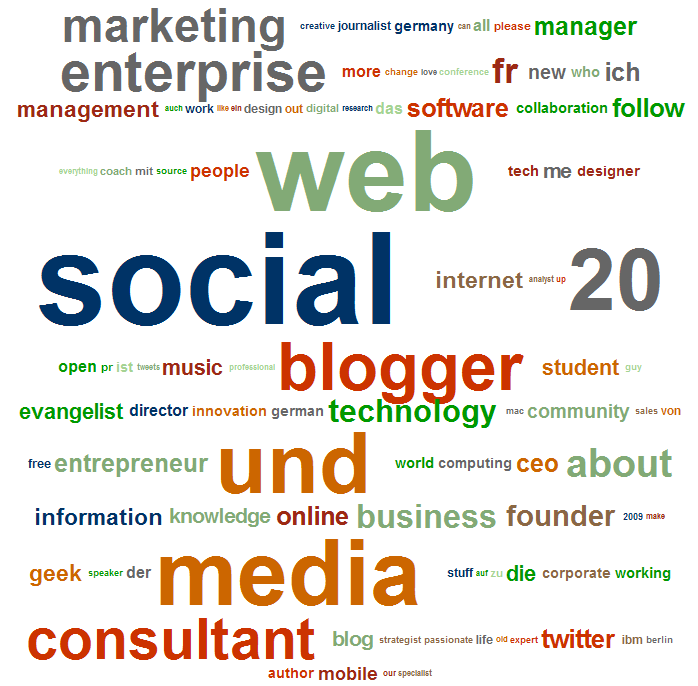Ungeschickterweise am gleichen Wochenende – das Knowledge Camp in Passau am 8. und 9. Okt. 2010 und das BarCamp München am 9. und 10. Oktober:
Da ist guter Rat teuer, man kann sich ja schließlich nicht aufteilen … und auch mein Freitag ist schon verplant. Manche Termine kann man als freelancing Berater einfach nicht umverlegen. Dies ist umso ärgerlicher als die bisher eingetragenen Sessionvorschläge für das KnowledgeCamp sehr interessant aussehen, u.a. mit Themen wie
– Community 2.0 – Schaden und Nutzen von sozialen Medien in Communites of Practice (Josef Hofer-Alfeis)
– Wie kann ein Wissensarbeiter den Überblick behalten? (Alexandra Dolff)
– Community Building im Netz (Friedrich Ittner)
– Motivation & Wissensmanagement (Boris Jäger)
– Persönliches Wissensmanagement – gibt es schon eine Handlungsempfehlung? (Andreas Matern)
– KnowledgeManagement vs KnowledgeEvolution (Karl-Heinz Pape)
– Knowledge Intelligence im Entreprise 2.0 (Thomas Hoppe)
– Ist Social Messaging der E20-Treiber? (Björn Negelmann)
Da wird mir wohl nichts anderes übrig bleiben als (wieder) darauf zu hoffen vertrauen dass die vernetzten Teilnehmer des #gfc10 die Diskussionen und Ergebnisse dokumentieren. Evtl. kann ich auch am Samstag während des BarCamps München in den Twitterstream aus Passau schauen, wie zuletzt beim Thementag Wissensmanagement.
Passend zum Thema plane ich eine Session “Persönliches Wissensmanagement” am BarCamp München Sonntag anzubieten, aufbauend auf den Notizen die u.a. hier in einem Titanpad gesammelt sind, und die evtl. noch mit Input aus Passau ergänzt werden.
Weitere interessante Sessions sind u.a.
– Xing richtig nutzen von (Torsten Maue)
– Datenschutz im Internet – Netzpolitik: Diskussion zu Forderungen an die Politik (Nikolaus Gradl)
– Die Todsünden der Selbständigkeit (Alexander Talmon)
– Die Zukunft des Social Web. Fragen statt Antworten (Franziska Schmid, Maren Martschenko)
– Maximen für Kleine Virtuelle Teams: Selbstorganisation, Routinen, leichtgewichtiges Projektmanagement (Martin Lindner)
– Anregungen und Tipps für Selbständige & Freiberufler, wie Social Media hilft, die eigene Reputation und Online-Sichtbarkeit zu stärken (Doris Schuppe)
Das ist bisher noch ein bisschen dünn für zwei Tage BarCamp – ich bin gespannt ob sich (selbstorganisiert) am Samstag morgen noch viele andere Themenvorschläge ergeben. Oder äußert sich hier auch eine kleine Minikrise des BarCamp Konzepts? Drehen wir uns gar um uns selbst, wie Dennis anlässlich des BarCamp OWL schreibt:
Mit Blick auf das Web 2.0 konstatiert SpOn-Autor Andreas Grieß, dass das Mitmach-Netz trotz steigender Nutzerzahlen noch nicht im Mainstream angekommen sei. Das Gleiche lässt sich für die BarCamp-Kultur feststellen. Speziell in Bielefeld hatte es den Anschein, als kämen viele alte Bekannte zu einem Happening zusammen. […] aus unserer Sicht hat der Kommunikationsraum „Unkonferenz“ nur auf Dauer einen Mehrwert, wenn es darum geht, möglichst viele Sichtweisen der Teilnehmenden zu verschränken und auch diejenigen zum Austausch zu motivieren, die bis dato noch nicht an einem offenen Erfahrungsaustausch teilgenommen haben. Gerade durch den Weg in den sogenannten Mainstream, also der breiten Öffentlichkeit, haben viele Themen, die ansonsten nur in Expertenkreisen besprochen werden, eine Chance auf gesellschaftliches Verständnis oder sogar Teilhabe. […] gerade bei einer Thematik wie dem Internet, die zur Kulturtechnik des aufsteigenden Jahrhunderts avanciert [sollte] aus unserer Sicht eine möglichst breite Bevölkerungsschicht angesprochen werden.
Mainstream wird es wohl nie werden, aber ich habe das Gefühl dass einiges an Kraft und Begeisterung verloren gegangen ist. Es ist zwar nett alte Bekannte und Freunde wiederzutreffen, aber eigentlich sollte doch gelernt, gearbeitet und gestaltet werden cialis rezeptfrei usa. Aktiv werden, mitmachen und mithelfen, mitdiskutieren und vom anderen lernen – das würde ich mir wünschen.
Warum bin ich so kritisch? Darauf hat es verschiedene Antworten, die einfachste ist die dass ich genau heute dreijähriges Twitterjubiläum habe – bzw. heute vor drei Jahren war ich bei meinem ersten BarCamp (es war das in München, ja) und habe in einer der ersten Sessions am Sonntag (?, Kosmar und Oliver waren dabei) von Twitter gehört. Noch in der Session habe ich mich angemeldet, die ersten Tweets verfasst und der Rest ist – wie so schön sagt – Geschichte. Der andere Grund für meine Kritik, nein, besser gesagt Sorge um das Format BarCamp hängt damit wiederum zusammen: ich habe das Gefühl dass ich auf den letzten (thematisch offen und allgemein konzipierten) BarCamps weniger gelernt habe als früher. OK, nicht an jedem BarCamp Wochenende kann man mit der Nase auf ein Twitter gestupst werden, aber dennoch. Klar, das könnte ein Phänomen von individuellem abnehmendem Grenznutzen sein, ein Zeichen abnehmender Innovationsdynamik im Social Web (sic!) oder sogar ein Hinweis darauf dass ich schon alles gesehen habe und schon alles weiß. Letzteres bezweifle ich aus guten Gründen …
Also woran liegt es und was kann man machen? Ersteres weiß ich nicht genau, würde es aber gerne beim BarCamp München diskutieren, letzteres kann ich nur für mich beantworten. Mehr Mühe in der Vorbereitung, mehr Gewitztheit bei der Ausgestaltung des offenen Formats Session, mehr Gewissenhaftigkeit bei der Nachbereitung, mehr Engagement bei den Gesprächen in den “freien Kommunikationsräumen” (auch Dennis, s.o.) – nagelt mich darauf fest. Schon dieses Wochenende. Ich versuche mehr mitzubringen als nur einen Sessionvorschlag.



